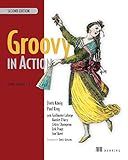Best Tools for Groovy's XML and JSON Builders to Buy in December 2025
Groovy provides a flexible and powerful way to create and manipulate XML and JSON structures using its builders.
For XML, you can use the MarkupBuilder class to build XML documents by creating nested closures to represent elements, attributes, and text nodes. This allows you to easily construct complex XML structures without dealing with verbose syntax.
Similarly, for JSON, you can use the JsonBuilder class to create JSON objects and arrays by chaining method calls to represent key-value pairs and arrays. This provides a concise and intuitive way to generate JSON data.
Both XMLBuilder and JsonBuilder classes offer a convenient way to work with XML and JSON data in Groovy, making it easier to create and manipulate structured data in your code.
What is the output format of JSON data created using Groovy's builders?
The output format of JSON data created using Groovy's builders is in standard JSON format. This means that the data is represented as key-value pairs and nested objects and arrays as per JSON specifications. For example:
{ "key1": "value1", "key2": { "nestedKey1": "nestedValue1" }, "key3": [1, 2, 3] }
This JSON data can then be easily parsed and read by other programming languages or applications that support JSON.
How to format XML output using Groovy's builders?
In Groovy, you can easily format XML output using the StreamingMarkupBuilder or MarkupBuilder classes. Here's an example of how you can use the StreamingMarkupBuilder class to format XML output:
import groovy.xml.StreamingMarkupBuilder
def writer = new StringWriter() def xml = new StreamingMarkupBuilder().bind { root { node1('value1') node2('value2') } }
writer << xml
println writer.toString()
This code snippet will generate the following formatted XML output:
You can customize the formatting further by adding additional properties to the StreamingMarkupBuilder instance, such as indent, charset, declaration, etc.
You can also use the MarkupBuilder class to achieve similar results with a slightly different syntax. Here's an example using MarkupBuilder:
import groovy.xml.MarkupBuilder
def writer = new StringWriter() def xml = new MarkupBuilder(writer)
xml.root { node1('value1') node2('value2') }
println writer.toString()
This code snippet will produce the same XML output as the previous example.
Both StreamingMarkupBuilder and MarkupBuilder classes are convenient options for generating formatted XML output in Groovy. You can choose the one that best suits your coding style and requirements.
What is the relationship between Groovy's builders and XMLSlurper?
Groovy's builders are used to create markup structures in a concise and readable way, while XMLSlurper is used for parsing and traversing XML documents in Groovy. Builders can be used to create and manipulate XML structures using a more convenient and intuitive syntax, while XMLSlurper is used for parsing and querying existing XML documents. So, the relationship between Groovy's builders and XMLSlurper is that builders can be used to create XML structures, which can then be parsed and manipulated using XMLSlurper.



